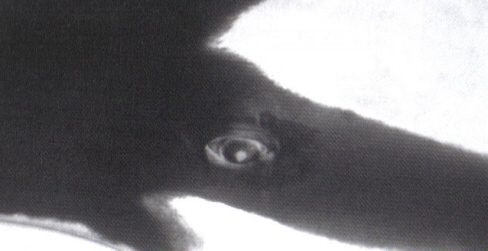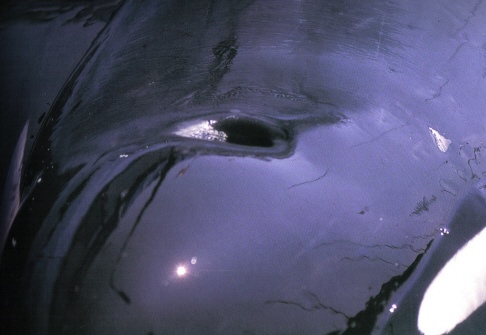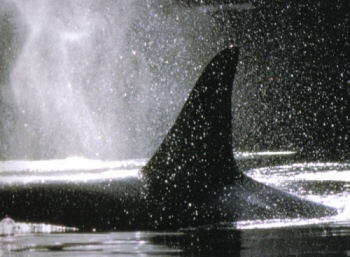

Orcas are beautiful creatures. Above, you can see the difference between the two genders. The most obvious feature, the one that makes distinguishing between the two genders as easy as pie, is the dorsal fin. Up to five feet in males, the fin is more curved and a LOT smaller on females. Another obvious difference is the fact that males can be twice as big as females. Males' tails are larger and as they grow, the tail flukes curl under. Also, the males have HUGE pectoral fins.
The colouring of an orca is very bold and not really designed for camouflage. That's because the orca has no natural enemies. However, it hides them enough so that their prey doesn't see them coming. They are mostly black on top, which blends in with the dark water seen from above, and mostly white on bottom, which blends in with the white water seen from below.
The orca's bright white patches practically shine in dark water, which makes it easy for its pod-mates to see where it is. This makes it easy for the pod to stay in unison.

Size
This photo should illustrate the difference in size between the two genders. Keep in mind, the male has not yet reached his full size in this photo. Even though I've already said this, I'll just write it out here again. Males can reach 22-27 ft in length, and weigh about 8000 to 12000 lb. Their dorsal fins can reach 6 feet in length (that's taller than some people!). Females are about 17-24 ft long, and weigh 3000 to 8000 lb. Their dorsal fins are usually about 3-4 feet high and are much more curved.
Above: Two orcas at SeaWorld Texas, Kyoquet, a young male, in the back, and Unna, a young female, in the front. This photo is copyrighted to Nicole Jardine.

Calf
The baby orca is called a calf. Calves look pretty much like miniature versions of their mom. When they are very, very young, their white patches are more orangey-pink than white. This fades to white as they grow. Calves often have blunt heads and stockier bodies.
Above: A full-body photo of a calf and her mother; the captive-born orca Kalina and her calf Skyla. This photo is taken and copyrighted by Nicole Jardine.

Eye Patch/Melon/Rostrum
This picture is a fantastic view of the orca's head. The white eye patch can be used as a way to identify an orca in captivity. The eye patch is NOT the eye; it is above the eye. In captivity, we have discovered that orcas may inherit the shape of their eye patch from their mother or father. Something else you can see in this photo is the orca's melon. All dolphins have a 'melon', which is the bulge on their forehead. Its made of fat, and is used as a sort of conductor for sound. Lastly, the rostrum is an orca's snout, just beneath the melon.
Above: An orca surges out of the water, scanned from Beyond the Whales by Alexandra Morton.

Eye
This is a photo of the orca's eye. The eye is directly under the front of the eye patch. The eye can be dark, or sometimes blue. Occasionally it can be red. The eye often goes unnoticed, because it blends in with the black skin. One orca in captivity has one blue eye and one brown eye!
Above; A beautiful photo of an orca's eye, from Beyond the Whales by Alexandra Morton.

Blowhole
This is a photo of the orca's blowhole. Like all toothed cetaceans (a fancy word for dolphins, whales and porpoises), orcas have one blowhole. Baleen whales have 2. A blowhole is what an orca breathes through. When the orca comes up for a breath, it opens the blowhole and lets out the explosive breath people are so used to hearing/seeing. Then it quickly sucks in a breath and closes the blowhole so that when it dives, the blowhole won't fill with water. An orca has to be careful not to get anything stuck in the blowhole, or it won't be able to breathe.
Above; a photo of an orca's blowhole, scanned from Orca: Visions of a Killer Whale by Peter Knudsten.

Teeth/Tongue
Orcas are toothed whales, which means, obviously, that they have teeth. Their teeth are conical and interlocking, good for anything from eating a salmon to eating a whale, to eating a shark! There are about 46 teeth in an average orca's mouth. Their tongues are pink and feel like sandpaper.
Above; an orca with its mouth open, from the book Orca: Visions of a Killer Whale by Peter Knudsten.
Below; a close-up on orca teeth, from Reader's Digest Explores Whales, Dolphins, and Porpoises.


Pectoral Fins
The fins on each side of an orca are called the pectoral fins; or pec fins for short. Pectoral fins contain bones that are like the bones we have in our arms; these bones are evidence that orcas once had arm-like features, thousands of years ago. The pectoral fins are used for steering mostly. They are paddle-like, and on males, very large. Some males may even have pectoral fins as long as their dorsal fins!
Above; A male orca waves his magnificent and amazingly huge pectoral fin in the air. Photo copyrighted to the Center for Whale Research. DO NOT USE WITHOUT PERMISSION!
Below: Two wild-caught captive orcas, Orky2 (now dead) and Corky2, perform a spectacular self-taught behavior, clearly showing the difference in size of pectoral fins between the two genders. This photo was scanned from In the Company of Whales by Alexandra Morton.


Dorsal Fin
The most prominant and noticeable feature of an orca is the dorsal fin, the fin on the back. Dorsal fins are unique to each whale, like the saddle patch (see below). The dorsals are more commonly used in identification, and are often very distinct. They can be 6 feet in males, and are generally 2-4 feet high on females. They typically act like a rudder, making it easy to stay on course. Dorsal fin shape is sometimes passed on from generation to generation, the most obvious example being the A30 matriline, where each orca has a very curved fin.
Above, a female orca's dorsal fin, from Orca: Visions of a Killer Whale, by Peter Knudsten.

Saddle Patch
Another identifying feature, the saddle patch lies just behind the dorsal fin. It is differently shaped for each orca, and is often scarred. There are two types of saddle patches-'open', when the saddle patch has some black in it, and 'closed' when it is all grey. The shades of grey vary. Saddle patches are NEVER open on transients, and southern residents have much more elaborate saddle patches than northern residents. Saddle patch shape can also be inherited by orcas.
Above, an orca's saddle patch showing identifying scars, from Beyond the Whales by Alexandra Morton.

Tail Flukes
The final feature of the killer whale is its tail. The flippers on either side of the tail are called flukes. When fully grown, male orcas have tails that curl under. The orca in this picture is obviously not an adult male. Flukes are used for lobtailing, and propelling the orca forward.
Above, a young orca lobtails, from Orca: The Whale Called Killer by Erich Hoyt.